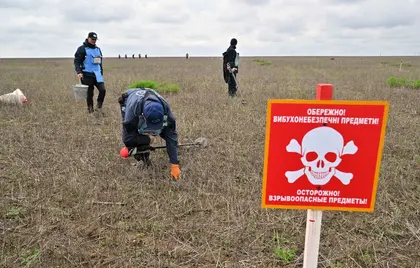Today, it is virtually impossible to think of any aspect of life in Ukraine not suffering the severe consequences of war. First – and most importantly – are the lost lives. This is followed by the sheer financial cost of material losses and devastation.
One of the most affected sectors is agriculture. Russia currently occupies large swathes of the country, while liberated Ukrainian territory is still heavily mined. Land subject to heavy shelling will be out of use for many years to come, potentially decades.
JOIN US ON TELEGRAM
Follow our coverage of the war on the @Kyivpost_official.
When farmers do tend to their harvests, there is a high probability they could be seriously wounded or killed by landmines. After harvesting, the grain then risks stagnating in ports or at the border, especially right now with Poland.
Just a few years ago, one could often hear Ukraine being talked up as an industrial and agricultural heartland, and as a world producer of grain. However, in the wake of Russia’s full-scale invasion, the situation has changed dramatically.
According to research by the International Center for Ukrainian Victory, since Feb. 24, 2022, the state has lost at least 19% of its cultivated land. During the full-scale war, 5 million hectares of Ukrainian land has been put out of use and heavily mined.
The research states: “Currently, Ukraine is the most mined country in the world. Arable fields are filled with unexploded shells and mines. The largest areas of mined lands in the South and East include the Dnipropetrovsk, Mykolaiv, Sumy, Kharkiv, Zaporizhzhia, and Kherson regions. More than 208,000 hectares need to be surveyed in the Kherson region, almost 160,000 hectares in the Kharkiv region, and more than 85,000 hectares in the Mykolaiv region… Without surveys and demining, the use of these lands by farmers is impossible.”

Erdogan to Pitch Plan at G20 to Freeze War, Postpone Ukraine’s NATO Bid
The price of harvesting in frontline areas might at best be destroyed equipment and at worst loss of life. Last year in October in the Kharkiv region, a combine harvester was blown up during harvesting, setting fire to the field. In July 2022, a farmer was blown up by a Russian mine while harvesting wheat in the Dnipro region. Within a month, others suffered the same fate in the Zaporizhzhia and Kyiv regions. These are just a few examples.
“A total of 188,000 square kilometers of Ukrainian soil is at risk of damage and pollution due to the war. As of July 2023, 298,000 hectares of forest and 1,438,000 hectares of grass fires were recorded in the combat zone. According to preliminary estimates, 5.5 million tons of pollutants were released into the air as a result of hostilities in Ukraine,” the study says.
It is also impossible not to mention the terrible man-made disaster – the explosion of the Kakhovka dam, with 550-600,000 hectares of irrigated land lost in the Kherson region. Together with the Dnipro and Zaporizhzhia regions, the losses amount to around 1.5 million hectares.
However, agrarians will continue to try to use all the land currently safe for their activities and for future harvest consumption. It might therefore seem that we can finish growing and harvesting – but it’s not that simple.
A further problem is where to store the grain. Russia has destroyed granaries with a capacity of about 10 million tons. And at least $1.3 billion will need to be spent on their restoration.
Added to the list of challenges is the export of harvested crops from Ukraine. At first, the grain was blocked along Black Sea ports for weeks as Russia disrupted the grain corridors with its provocations. Now it’s standing at the border with Poland, with Polish farmers blocking transportation.
Ukrainian drivers have already died in kilometer-long queues, and on Feb. 11, an incident occurred that upset many Ukrainians population. Polish farmers opened three trucks and emptied out the grain – about three tons from each.
The protest in Poland was reportedly organized by the representative of the pro-Russian party Rafal Mekler, which once again shows that all the problems currently associated with Ukrainian grain have been brought on by the actions of the enemy.
Despite the many numbers in this article, as long as a large part of Ukrainian territory remains occupied and the enemy continues to strike, it is impossible to accurately calculate the losses for Ukraine’s agricultural sector. It is also impossible to guess just how much longer all this will last.
The views expressed are the author’s and not necessarily of Kyiv Post.
You can also highlight the text and press Ctrl + Enter






